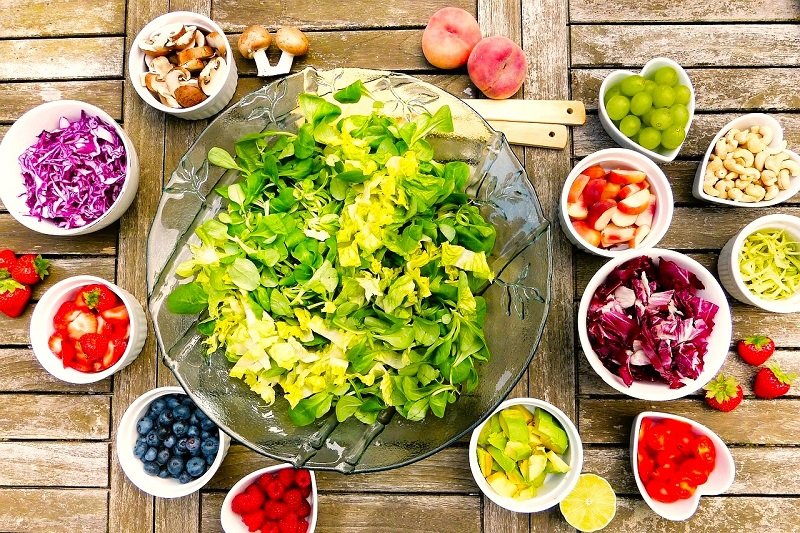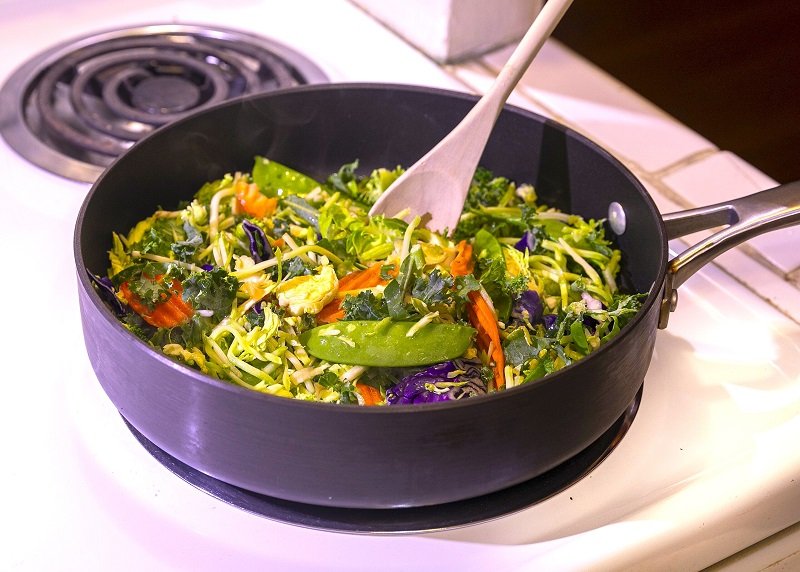We are all familiar with the age-old advice – ‘eating more fruits and vegetables’; it seems to be on repeat. As we age, incorporating these dietary changes can be as challenging as unravelling tangled headphone wires. While we understand the importance of this advice, especially as we celebrate more birthdays.
While acquiring this knowledge is important, applying it can often seem as daunting as attempting to squeeze a kangaroo into a telephone booth. So, how can we put this knowledge into action? How can we transform our fruit bowl into a hero and highlight the importance of vegetables?
Let’s explore the benefits of incorporating a variety of fruits and vegetables into our diet and how it can improve our overall health and well-being.

Eating More Fruit and Vegetables Can Become More Challenging as You Age
Doctors and nutrition experts regularly emphasize that good senior nutrition requires eating more fruit and vegetables as we grow older. Despite what the experts recommend, seniors seem to be eating fewer fruits and veggies these days.
This is worrisome because these foods are super important for keeping chronic illnesses at bay. Let’s all remember to munch on more fruit and veggies for a healthier life!
Prefer to listen rather than read?

The decrease in fruit and vegetable consumption is especially noticeable in low- and middle-income countries, where access to food can be challenging. Surprisingly, researchers have also noted a concerning decline in produce intake among older adults in developed nations. It appears that as people age, they are not increasing their consumption of fruits and vegetables.
A recent research study conducted by the Better Health Foundation uncovered taht older Americans, much like individuals in developing nations, are currently consuming fewer fruits and vegetables.
The Better Health Foundation researchers said American adults aged 50 and above, who traditionally consume higher amounts of fruits and vegetables, have experienced the most notable decreases in their intake of fruits and vegetables in recent years.
The Health Benefits of Eating More Fruit and Vegetables
As we age, it is crucial to incorporate a diverse range of fruits and vegetables into our daily meals. These nutrient-dense foods are packed with essential vitamins, minerals, and antioxidants that enhance our immune system and support the rejuvenation and repair of cells in our body.
Because of their rich nutritive properties, eating more fruit and vegetables every day helps to strengthen your body’s defences against a wide variety of age-related health issues.
Eating More Fruit and Vegetables Helps to Prevent Cancer in Older People
Studies have shown that fruits and vegetables possess properties that help prevent cancer. Scientists have found that both vegetables and fruits contain sulphides that activate enzymes to reduce the risk of cancer.
Data from recent research also indicates that the carotenoids and flavonoids in fruits and vegetables aid in the regulation of cell growth and differentiation. This helps the body prevent uncontrolled growth and formation of tumours.
That’s not all. Quite several fruits and vegetables contain indoles that can impede cancer development; phenols that prevent the creation of cancer-causing substances in the body; and tannins that counteract the effects of carcinogens.
Broccoli, brussels sprouts, cabbage, and kale are particularly high in indoles. Blueberries, strawberries, raspberries, and blackberries are rich in phenolic compounds. So are apples and citrus fruits. Tannins are found in various plant-based foods such as tea, especially green tea. Vegetables like onions, spinach, and eggplant also contain cancer-fighting tannins.

Eating More Fruit and Vegetables Lowers the Risk of Strokes and Heart Attacks in Older Adults
Findings from several studies suggest a strong correlation between fruit and vegetable consumption and reduced risks of heart disease and stroke. Many vegetables and fruits are rich in vitamin C and beta-carotene, in particular. Both are powerful antioxidants that occur naturally in the body.
Both help to slow and prevent the buildup of plaque from cholesterol and other substances in the arteries. This helps to protect you against heart disease.
That said, if you haven’t been eating fruit and vegetables for a while, you should go for regular heart health checks to track your cardiovascular fitness. When it comes to cardiovascular health, it always pays to be vigilant and aware.

Increased Fruit and Vegetable Intake Reduces the Risk of Type 2 Diabetes in Seniors
Fruits and vegetables are rich in dietary fibre. Researchers have long linked high-fiber diets to a reduced risk of Type 2 diabetes. Fiber helps regulate blood sugar levels by slowing down the absorption of sugars into the bloodstream, preventing rapid spikes in blood glucose after meals.
Fruits and vegetables are also nutrient-dense while being relatively low in calories. This is how eating more consuming more healthy, low-calorie fruits and vegetables can help seniors maintain a healthy weight.
This reduces the risk of obesity among older people. Scientists have long established the connection of obesity with Type 2 diabetes. Research has also linked certain nutrients found in fruits and vegetables, such as magnesium and potassium, with improved insulin sensitivity.
Swiss chard and kale have high magnesium content. Oranges, bananas, and potatoes are rich in potassium; while spinach contains high amounts of both magnesium and potassium.
The antioxidants and phytochemicals in fruits and vegetables also have anti-inflammatory properties. These chemical properties help to combat oxidative stress in the ageing body. Oxidative stress is a significant contributing factor in the development of insulin resistance.
By maintaining or improving insulin sensitivity, seniors can better manage blood sugar levels and reduce their risk of developing Type 2 diabetes.

Fresh Fruit and Vegetables Help to Prevent and Delay Cognitive Decline in Seniors
While there’s no known way to reverse dementia in older people, emerging research suggests that eating more fruits and vegetables can delay – or reduce the risks – of the disease among seniors.
Apart from contributing to insulin resistance, oxidative stress also damages human brain cells. Because eating adequate helpings of fresh produce daily helps to combat oxidative stress, it can also reduce the risk of cognitive decline in seniors.
Certain fruits and vegetables – such as berries and leafy greens – are known to improve blood flow. Better blood circulation to the brain ensures it receives adequate oxygen and nutrients. This promotes healthy brain functions. Research shows that vigorous and active brain functions help to reduce the risk of cognitive decline.
Overall, the essential vitamins, minerals, and fibre in fresh produce support not only physical health but also healthy and resilient brain function.

5 Ways to Make Eating More Fruit and Vegetables Fun and Easy for Seniors
For many seniors, increasing fruit and vegetable intake may require dietary and lifestyle changes that can be difficult to manage. Over time, our perception of taste may change, making certain foods less appealing. More seniors than you think find fruits and vegetables less enjoyable because of changes in their taste sensitivity.
The number of taste buds on the tongue tends to decrease as people age. This decline is an inevitable part of the ageing process. However, fewer taste buds can often make food taste dull and flavourless for seniors, which ultimately makes the consumption of fruit and vegetables less appealing.
If you are among those who are struggling to find ways around the problem, fret not. We’re here to help. Below are five fun ways to make eating more fruit and vegetables easier and more appealing for you.
1. Add Ample Helpings of Fruit and Vegetables to Food You Like to Eat
The trick to making any successful change in longstanding habits is to begin slowly. Rather than altering your entire dietary regimen to accommodate more fresh produce, you can make eating more fruit and vegetables easier by adding them to food you have always enjoyed.
Fruits and berries add natural sweetness and extra vitamins to your morning meals. Stirring fruits like berries, bananas, or apples into cereal in the morning helps many seniors increase their fruit consumption. We think this little innovation is an excellent way to start eating more fruits.
You can also try adding strawberries or blueberries to your pancake batter before cooking. This not only introduces fruit flavours into your pancakes but also increases their nutritional content. You can boost the nutritional content of your lunch sandwiches by adding extra vegetables like lettuce, tomatoes, cucumbers, bell peppers, or avocado.
This will add crunch and flavour to your favourite sandwiches even as the vegetables in them provide you with much-needed vitamins and fibre. There are countless other ways to “trick yourself” into eating more fruit and vegetables with your favourite foods.
Be creative and do not hesitate to experiment. You’ll eventually find more ways to incorporate fruits and vegetables into the food you like to eat as you go along.

2. Avoid Junk Food
Eating more fruit and vegetables means avoiding unhealthy snacks and junk food. The results of a study published in BMC Public Health in 2018 suggest that eliminating junk food from your diet will almost certainly increase your appetite for fruits and vegetables.
Junk food products typically contain high levels of sugar, salt, and unhealthy fats. They can trigger irresistible cravings and pangs for even more unhealthy foods. This is likely to suppress your appetite for fruits and vegetables.
By cutting down on junk food, seniors will find themselves more inclined to choose healthier alternatives. This new openness to healthy food makes eating more fruit and vegetables easier and more appealing.
When seniors eliminate unhealthy snack foods from their diet, they give their appetite time to recalibrate, which soon leads to a clean and refreshed palate that is more open to consuming fruits and vegetables to satisfy hunger.

Junk food products typically contain high levels of sugar, salt, and unhealthy fats.
3. Go Vegetarian One Day a Week
Including a day of vegetarian meals in your weekly dietary routine is likely to encourage you to explore a wider range of vegetables, fruits, legumes, and whole grains. This resulting diversification introduces a broader spectrum of vitamins, minerals, antioxidants, and phytonutrients into your diet. That’s an exciting way to make sure you are eating more fruit and vegetables.
There are many delicious and healthy vegetarian dishes out there for you to explore. For example, Vegetable Sir-Fry usually consists of a mix of colourful vegetables with tofu or tempeh. It’s convenient, quick, delicious, and surprisingly easy to cook.
When seasoned to perfection with soy sauce, ginger, and garlic, this Asian-inspired dish is best served over a bowl of steaming hot rice or noodles.

Vegetarian Chili is a hearty dish made with beans (kidney beans, black beans, or lentils), tomatoes, onions, peppers, and spices like cumin and chilli powder. This Mexican-inspired vegetarian dish is an utterly irresistible treat when served with rice, too.
Vegetable Curry is an extra-flavorful dish with a base of coconut milk or tomato sauce. You can cook it using a variety of vegetables. Potatoes, cauliflower, peas, and carrots are the typical choices. Season with curry powder or garam masala for that authentic Indian flavour.
If you enjoy mopping up hearty, savoury stew sauces with bread, try pairing Vegetable Curry with Indian flatbreads. Delicious!
If you want to learn more about vegetarian cooking, you’ll find many excellent vegetarian cookbooks available online. You can also try enrolling in an online class for a more well-rounded understanding of vegetarian diets and culinary techniques.

4. Eat Fruits and Vegetables That Are in Season
Eating more fruit and vegetables is easier when you choose produce that is in season. Seasonal fruits and vegetables are harvested at their peak ripeness. This is when all kinds of produce come to mature to superior taste, flavour, and appearance. That makes them more appealing to both the eyes and the palate.
For example, in-season bell peppers come in bright hues of red, yellow, orange, and green. They are firm, glossy, and exhibit a vibrant colour. They’re also sweeter and crisper during their peak season. Spinach has a vibrant dark green colour, crisp leaves, and a fresh, slightly earthy taste when in peak season. Spinach is more tender and flavorful during its peak season.
Perfectly ripened apples are a vigorous red. Strawberries at their peak have a glossy sheen, and a sweet, juicy flavour. They tend to be larger, plumper, and more aromatic when in season. Blueberries have a deep blue or purple hue, are firm to the touch, and have a sweet-tart taste. In-season blueberries are often larger, juicier, and have better overall flavour, too.
Seasonal produce is typically fresher and retains more nutrients compared to fruits and vegetables that are stored for longer periods or transported from distant locations.
The higher nutrient content of produce harvested in season contributes to a better overall eating experience and is more likely to increase appeal. In-season produce smells, looks, and tastes fresh, which makes eating more fruit and vegetables easier and more enjoyable.

5. Eat a Healthier Diet by Trying New Fruits and Vegetables
The next time you visit the grocery store, expand your palate by picking fruits or vegetables you have not tasted before. Visit and shop for fresh produce at the local farmer’s market. Ask the sellers about the produce on display. Which ones are best served fresh? Which ones are best for cooking?
Selecting something unfamiliar can introduce you to unique flavours, textures, and nutritional benefits. The novelty of the experience makes eating more fruit and vegetables a good deal more interesting.
For an even more diverse and exciting experience, consider signing up for regular produce deliveries through your Community Supported Agriculture (CSA) program. CSA initiatives connect consumers directly with local farmers. They usually support both the community and sustainable agricultural practices.
By subscribing to a CSA, you receive a seasonal variety of fresh, locally grown produce, often delivered right to your doorstep. Check if your community is involved in a CSA program or something similar. CSA programs and the like are quite popular the world over.

It’s About Consistent Progress Rather Than Instant Results
For many seniors, eating more fruit and vegetables involves altering established dietary patterns. That goal requires planning meals, discovering new recipes, and finding creative ways to incorporate these foods into daily eating routines.
Switching to a fruit and veggie-focused diet takes time, dedication, and a new mindset. Experimenting with recipes and meal planning is key. Embrace the health benefits and environmental impact of plant-based eating. Transitioning to this lifestyle requires patience and persistence.
After all, healthy living is a long-term investment. Learning to live a more wholesome lifestyle is about consistent progress rather than big, instant results. Eating more fruit and vegetables requires careful and well-considered meals, as well. It involves calm, conscious, and steady improvements in dietary choices, portion sizes, and overall nutrition over time.
Having a clear-cut purpose will be helpful, of course – whether you want to improve your overall health, manage your weight, prevent diseases, or simply want to age healthier. What do you think?
Frequently Asked Questions About Eating More Fruits and Vegetables
- I’m on a fixed budget. Are fruits and vegetables expensive?
- Fresh produce can fit into any budget with smart shopping strategies. Frozen fruits and vegetables are just as nutritious as fresh and often cost less. Buy seasonal produce when it’s most affordable, consider joining a CSA for bulk savings, and don’t overlook canned options (choose varieties without added sugar or sodium). Root vegetables, bananas, and leafy greens typically offer the most nutrition per dollar.
- What if I have trouble chewing or digesting raw vegetables?
- If slicing and chopping is a challenge, choose frozen, canned, or ready-to-eat options. Cooking vegetables often makes them easier to digest – try steaming, roasting, or adding them to soups. Smoothies are excellent for getting nutrients from both fruits and vegetables without the chewing challenge. Start with mild-tasting options like spinach in fruit smoothies.
- Do I need to eat organic fruits and vegetables?
- Organic produce can be beneficial but isn’t necessary to gain health benefits from fruits and vegetables. The most important thing is eating more produce, regardless of whether it’s organic or conventional. If budget allows, consider choosing organic for the “Dirty Dozen” (fruits and vegetables with higher pesticide residues) and conventional for the “Clean Fifteen.”
- Can I count 100% fruit juice toward my daily fruit intake?
- Whole or cut-up fruits are sources of dietary fiber, while juice lacks this beneficial fiber. Small amounts of 100% fruit juice can count toward your daily intake, but whole fruits are more filling and nutritious. If you enjoy juice, limit it to 4-6 ounces per day and choose varieties without added sugars.
- What’s the best time of day to eat fruits and vegetables?
- There’s no “perfect” time – the best time is whenever you’ll actually eat them! Some people prefer fruit as morning energy, others as afternoon snacks. Including vegetables at lunch and dinner ensures you’re spreading nutrients throughout the day. The key is consistency rather than timing.
- How do I make vegetables taste better without adding too much salt or butter?
- Experiment with herbs and spices like garlic, rosemary, thyme, or paprika. Experiment with low-salt herbs and spices. Roasting vegetables brings out natural sweetness, while a splash of balsamic vinegar or lemon juice can brighten flavors. A small amount of olive oil helps your body absorb fat-soluble vitamins.
- Are frozen and canned fruits and vegetables as healthy as fresh?
- Yes! Frozen fruits and vegetables are picked at peak ripeness and flash-frozen, preserving their nutritional value. They’re convenient, have a longer shelf life, and can be more affordable than fresh. For canned options, choose varieties without added sugars (fruits) or excess sodium (vegetables). Rinse canned vegetables before using to reduce sodium content.
- I have diabetes. Can I still eat fruits?
- Fruit contains carbohydrate so you need to count it as part of your meal plan. Having a piece of fresh fruit or fruit salad for dessert is a great way to satisfy your sweet tooth and get the extra nutrition you’re looking for. Focus on whole fruits rather than juices, pair fruit with protein or healthy fats to slow sugar absorption, and work with your healthcare provider to determine appropriate portions for your individual needs.
REFERENCES
- JEVS Human Services. (2024, April 12). 5 Fruits and Vegetables for Senior Diets.
- National Center for Biotechnology Information. (2023). Fruit and vegetable intake among older adults: a scoping review.
- MyPlate.gov. (2024). Nutrition Information for Older Adults.
- Chefs for Seniors. (2023, October 12). 10 Tips For Seniors to Eat More Fruits and Veggies.
- National Center for Biotechnology Information. (2023). Increased Fruit and Vegetable Intake among Older Adults Participating in Kentucky’s Congregate Meal Site Program.
- National Council on Aging. (2024). The 8 Best Superfoods for Seniors.
- Lee, S. H., et al. (2022). Adults Meeting Fruit and Vegetable Intake Recommendations — United States, 2019. MMWR Morbidity and Mortality Weekly Report, 71(1), 1-9.
- Aune, D., et al. (2017). Fruit and vegetable intake and the risk of cardiovascular disease, total cancer and all-cause mortality—a systematic review and dose-response meta-analysis of prospective studies. International Journal of Epidemiology, 46(3), 1029-1056.
- American Institute for Cancer Research. (2022, July 28). Do Fruits, Vegetables Protect Against Cancer?
- Li, M., et al. (2016). Higher intake of fruits, vegetables or their fiber reduces the risk of type 2 diabetes: A meta‐analysis. Journal of Diabetes Investigation, 7(1), 56-69.
- MyPlate.gov. (2024). Fruit Group – One of the Five Food Groups.
- American Diabetes Association. (2024). Best Fruit Choices for Diabetes.



